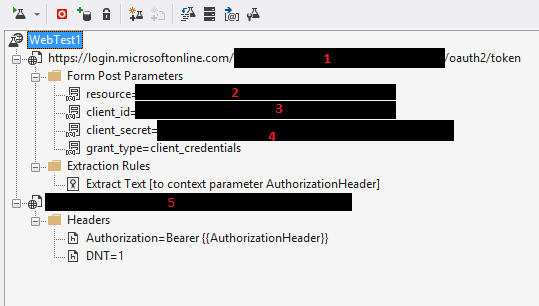Azure Webtest and JWT bearer token authentication
Hello, if you guys are trying to use Azure Webtest to maintain the availability of your web apps and running into the problem that WebTest needs to test against a secured web apis and still haven’t figured it out yet then this is the article that you are looking for. Firstly, let’s read these 2 for basic understanding this article from MS and this article. Ok, you read it right? If you got your solution then it’s awesome, if you haven’t? don’t worry. Let’s begin. What you need to do is preparing:
- An application in AAD, go to Configure section of your app and you will have (CLIENT ID, CLIENT SECRET (KEY))
- Go to Visual Studio and create new WebTest project. Let’s set up everything like this.

Block 1: your tenant id or tenant uri
Block 2: important it can be either your client ID or APP ID URI (they are all in Azure AD configure page). I will talk about it later.
Block 3: client id
Block 4: client secret
Block 5: your secured api to be tested.
Ok, so let’s talk about block 2. This value really depends on how your server sets up. Here, I will use .net core as an example. Here is how I set up my app.

My server expects client to send bearer token if user is authenticated. Configuration[“AzureAd:Audience”] is my client Id. Here is the tricky part: The value of Block 2 needs to be matched with Audience value inside UseJwtBearerAuthentication. It means if I am using client Id here then my block 2 value should be client Id as well. That’s the most tricky part. Now if you look at the first image, after the first request you will get AuthorizationHeader and it contains the access token. So the next step is extract it and send it with the second request. Unfortunately, you will need to modify the code a little bit. Let’s generate code from our Webtest. this.Context[“AuthorizationHeader”] is a JSON object. This code will extract access token.
JToken token = JObject.Parse(this.Context["AuthorizationHeader"].ToString());
WebTestRequest request2 = new WebTestRequest("your_api_url");
request2.Headers.Add(new WebTestRequestHeader("Authorization", ("Bearer " + token.SelectToken("access_token").ToString())));Happy coding!
Hung Cao